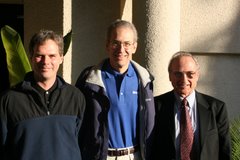Derivatives are not measured directly in the field; rather, they are computed by numerical differentiation from drawdowns collected during a pumping test. Straightforward calculation of the derivative from neighboring drawdown measurements typically leads to noisy derivative data. Therefore, smoothing routines are employed to obtain a cleaner derivative signal (Bourdet et al. 1989; Spane and Wurstner 1993).
To appreciate the importance of derivative smoothing, consider field data measured in a deep piezometer during a constant-rate pumping test performed in an unconfined aquifer (Kruseman and de Ridder 1994). Figure 1 is a derivative plot for the piezometer showing drawdown (squares) and derivatives (crosses) computed without smoothing (nearest neighbor method). Without smoothing, the derivative data provide little useful information for the interpretation of this test.
 |
| Figure 1. Derivative plot showing derivatives computed without smoothing. |
 |
| Figure 2. Derivative plot showing derivatives computed with Bourdet smoothing. |
More information on derivative analysis is available at Aquifer Testing 101.



No comments:
Post a Comment